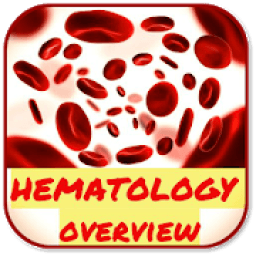
Are you finding some interesting apps? 20,000+ users downloaded Hematology Overview latest version on 9Apps for free every week! The app is superior that can be used with any of the mobile type. This hot app was released on 2019-04-17. To read more information, you can go to 9Apps.
Hematology Overview
Hematology is the study of blood and the disorders related to it. Human blood is composed of ∼45% cellular components and ∼55% plasma. Blood has many functions, including transporting oxygen, regulating body temperature, and supporting the immune system. The cellular component consists of three major cell types, all of which arise from hematopoietic stem cells located primarily in the bone marrow: red blood cells (RBCs), white blood cells (WBCs), and platelets. Red blood cells (RBC, erythrocytes) are hemoglobin-carrying cells that primarily transport oxygen. White blood cells (WBC, leukocytes) take the form of either granulocytes or lymphocytes. Granulocytes are part of the innate immune system and play a key role in the immune response to bacteria, fungi, and parasites. Lymphocytes are highly antigen-specific, meaning they are able to target specific infectious agents, primarily viruses. Platelets are the other major cellular component of blood and are small anucleate cells produced from megakaryocytes in the bone marrow. This learning card provides an overview of the production, morphology, and most important functions of blood cells.
ask novartis hematology
atlas of hematology
basic hematology
essential hematology
hematology
hematology app
hematology atlas
Introduction
Function of blood
Transports oxygen, nutrients, metabolic waste products
Regulation of body temperature, signal transmission, acid-base homeostasis, and immune response
Composition of blood
60–80 mL blood/kg body weight ≅ 5 L blood for an adult weighing 70 kg/154 lbs
45% cellular components (→ hematocrit), 55% plasma
Production of blood
Location: bone marrow; the spleen and liver are the primary sites before birth
Hematopoietic stem cells can differentiate into any type of blood cell and give rise to all blood cells through the following two precursor cells:
Lymphoid precursor cells: origin of lymphocytes and natural killer cells
Myeloid precursor cells: origin of erythrocytes, granulocytes, and megakaryocytes
Left shift (or blood shift): an increase in immature precursor cells (e.g., increase in band neutrophils with rod-shaped nuclei in response to acute inflammation) in the blood. In most cases, infection is the cause of a left shift.
A reactive increase of a cell line ends in "-cytosis" (e.g., leukocytosis); neoplastic increase is referred to as "-emia" (e.g., leukemia).
Overview
Bone marrow is the spongy, soft tissue that fills the hollow spaces within cancellous (spongy) bone. It is composed of stromal cells and stem cells, which are the progenitors of all five blood cell lineages. Hematopoiesis is the main function of the bone marrow. It also filters aging RBCs and houses immune cells (e.g., plasma cells).
Ikhtisar Hematologi
Hematologi adalah studi tentang darah dan gangguan yang berkaitan dengannya. Darah manusia terdiri dari ∼45% komponen seluler dan ∼55% plasma. Darah memiliki banyak fungsi, termasuk mengangkut oksigen, mengatur suhu tubuh, dan mendukung sistem kekebalan tubuh. Komponen seluler terdiri dari tiga jenis sel utama, yang semuanya muncul dari sel batang hematopoietik yang terutama terletak di sumsum tulang: sel darah merah (sel darah merah), sel darah putih (sel darah putih), dan trombosit. Sel darah merah (RBC, eritrosit) adalah sel pembawa hemoglobin yang terutama mengangkut oksigen. Sel darah putih (leukosit, leukosit) berbentuk granulosit atau limfosit. Granulosit adalah bagian dari sistem kekebalan tubuh bawaan dan memainkan peran kunci dalam respons kekebalan terhadap bakteri, jamur, dan parasit. Limfosit sangat spesifik antigen, artinya mereka dapat menargetkan agen infeksi spesifik, terutama virus. Trombosit adalah komponen seluler utama darah dan merupakan sel anukleat kecil yang dihasilkan dari megakaryocytes di sumsum tulang. Kartu pembelajaran ini memberikan gambaran umum tentang produksi, morfologi, dan fungsi paling penting dari sel darah.
tanya hematologi novartis
atlas hematologi
hematologi dasar
hematologi esensial
hematologi
aplikasi hematologi
atlas hematologi
pengantar
Fungsi darah
Mengangkut oksigen, nutrisi, produk limbah metabolisme
Pengaturan suhu tubuh, transmisi sinyal, homeostasis asam-basa, dan respons imun
Komposisi darah
60–80 mL darah / kg berat badan ≅ 5 L darah untuk orang dewasa dengan berat 70 kg / 154 lbs
45% komponen seluler (→ hematokrit), 55% plasma
Produksi darah
Lokasi: sumsum tulang; limpa dan hati adalah situs utama sebelum kelahiran
Sel induk hematopoietik dapat berdiferensiasi menjadi semua jenis sel darah dan memunculkan semua sel darah melalui dua sel prekursor berikut:
Sel prekursor limfoid: asal limfosit dan sel pembunuh alami
Sel prekursor myeloid: asal eritrosit, granulosit, dan megakaryocytes
Pergeseran kiri (atau pergeseran darah): peningkatan sel prekursor yang belum matang (mis., Peningkatan neutrofil pita dengan inti berbentuk batang sebagai respons terhadap peradangan akut) dalam darah. Dalam kebanyakan kasus, infeksi adalah penyebab pergeseran kiri.
Peningkatan garis sel secara reaktif berakhir dengan "-cytosis" (mis., Leukocytosis); peningkatan neoplastik disebut sebagai "-emia" (mis., leukemia).
Ikhtisar
Sumsum tulang adalah jaringan lunak sepon yang mengisi ruang kosong di dalam tulang cancellous (sepon). Ini terdiri dari sel-sel stroma dan sel-sel induk, yang merupakan nenek moyang dari semua garis keturunan sel darah. Hematopoiesis adalah fungsi utama dari sumsum tulang. Ini juga menyaring sel darah merah yang menua dan menampung sel-sel kekebalan tubuh (mis., Sel plasma).